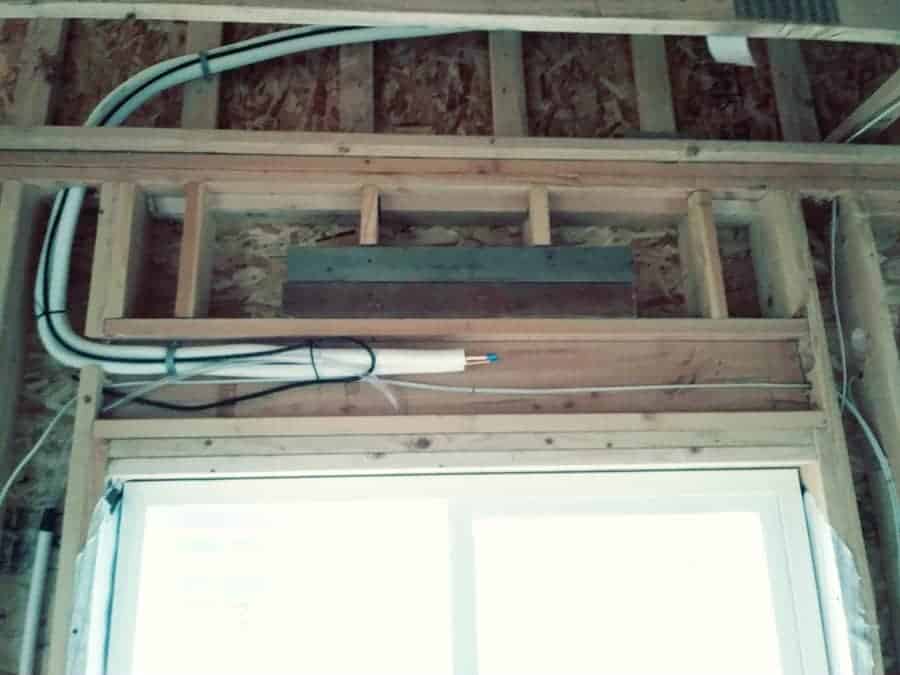The line set is the main connection between the indoor and outdoor units of your split system AC or heat pump. It carries the coolant (or Freon as most people know it as) between the units.
New line sets are highly recommended but not always necessary when replacing an air conditioner or heat pump. I replace the line set on every job unless the line set is inaccessible. Line sets can be very hard to replace if they were installed in walls during new construction or built over during a remodel.
Even when a line set in inaccessible I will try to reroute it to make sure I have good solid clean copper lines with no leaks or kinks.
Like the line set in the image below, when the wall is insulated and sheet rocked, I’m not gonna wanna replace it for love nor money. This is where a flush kit (more about flush kits later) would be used or run the line set in a different route. Exposed maybe with a covering.

The big question most of my customers have when I include a new line set in their quote is: “Why do I need new copper lines, they are already there?” And if the line set can be flushed why don’t we save some money and flush them?
There is more than one answer to why we don’t want to keep a flushable existing line set. They do make pretty decent flushing kits. I’ve used them, they consist of a canister with R-11 refrigerant and are easily available on Amazon. Click on my link here to get an eyeball on it.
Flush kits are used to eliminate moisture, acid, oil and other contaminates from the inside of existing line sets. Acid can form inside a system when the oil in a compressor over heats or becomes contaminated for various reasons. This contaminated oil can hide inside a line set and be introduced into a new system if not removed completely.
You have probably heard that new systems use a more climate friendly refrigerant named R410A. Older systems used R-22 refrigerant that was claimed by the EPA to be damaging to our ozone layer and a major cause of climate change.
This newer more climate friendly refrigerant R410A, that is used in residential air conditioners and heat pumps uses a synthetic oil in the compressors. Not so with R-22 systems.
The R-22 units used a more standard oil and that oil does not mix well with the synthetic oil. It would actually turn to a nasty gel inside your new system if left inside an old line set. So is a few hundred bucks worth the risk?
So now that you know what a flush kit is used for, do you want to take a chance on not getting a good enough flush?
Some technicians claim that triple evacuation will remove the old refrigerant and then you’re safe to go and reuse the old line set. Evacuation is a process of placing a vacuum pump in the line set and drawing the line set into a vacuum. In a vacuum the R-22 dissipates into the atmosphere. It’s called an indiscriminate amount and that is allowed.
True it will remove the R-22 and some contaminates, but not any trapped oil. That’s where you need a flush kit or a new line set.
Is There Anything I Should Know About A New Line Set?
Just a couple of tips to make you a educated home owner. When your new line arrives and you can take a peek at it, check to make sure the ends are plugged. The factory installs different types of caps to cover the ends.
I’ve received a few line set where the ends are smashed of to seal the lines. This is an acceptable way to get a good seal. You just cut the ends off and you’re ready to go.
Not having a capped end can allow debris, bugs or even moisture to get into the line set. Not a likely event but who wants to take a chance on the future life of a heat pump or air conditioning unit. Debris in a line set can plug the tiny orifices inside a refrigeration system. A new line can be purged or blown out with nitrogen.
Make sure the lines have no kinks either before or after an installation. Kinks can be a future leak and a restriction in the flow of refrigerant or Freon.
Line sets come with two copper lines. One insulated and the other not. Most of the jobs I’ve ordered in the last couple of years have been coming with line sets that have a white insulation that is much more durable than the black rubbery types that have been used for many years.
The larger of the two line is generally called the suction line. With AC only units it will be cold while the unit is running. With a heat pump it will be cold while in the cooling mode and hot while in the heat mode.
Suction lines are cold – 40°F (4.4°C) SST – and cause condensation, even in conditioned spaces. In addition, any heat that enters the refrigerant adds to the superheat and reduces system efficiency.
inspectapedia
For these reasons, suction lines should be insulated with a vapor proof insulation. This is a requirement of many building codes. Rubatex is the most common form of refrigerant line insulation.
The black insulation is very easily torn and can look bad when exposed to sun for a few years. It’s easily repaired with some new material and some contact cement, but seldom does anybody do those simple maintenance and repair jobs.
All together the exposed portion of a line set is a very small percentage of the overall line and that doesn’t drastically effect the efficiency of a system. I just looks bad when the insulation is all torn up.
If you look down inside through the top of an outdoor unit you can see all kinds of bare piping with no insulation. So don’t stress over a few feet of exposed refrigeration piping.
Also if you have the opportunity to ask for a higher grade of insulation on the line set you can gain a very slight amount of efficiency by doing so. In some areas of the country it is a requirement to have the thicker insulation.
Conclusion
It’s only natural to want to save a little money, especially when making a big purchase like a new HVAC system. Using an existing line set is what some companies do to cut corners. Not always. Their are some sensible reasons to reuse a line set. I think I covered those reasons.
Be sure you make a wise choice. The cost of making the wrong choice in this instance can be very, very expensive. To say nothing of the head aches. The loss of heating or cooling for the time it take to get someone out and make the repair. If a repair is even a wise thing in itself.
